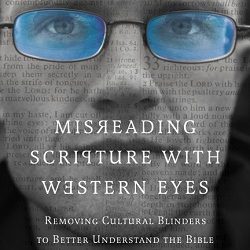Misreading Scripture with Western Eyes
- Approximate Time Commitment: 10 minutes
Misreading Scripture with Western Eyes by E. Randolph Richards and Brandon J. O’Brien focuses on the relationship and differences between the biblical world and our contemporary world and how that affects how we read and interpret the Bible. This book review was written by Hank Griffith from South Suburban Evangelical Free Church in Apple Valley, Minnesota. This would be a great book for anyone desiring to get to the deep roots of meaning contained in Scripture, especially for those engaged in cross-cultural models.
Resource Description
Full Review:
I recommend this delightful, easy-to-read book that is especially targeted to missionaries but could be helpful to all Christians as we increasingly relate to people from diverse ethnic backgrounds in our churches. This book helps us realize how much our view of Christianity, including our reading of the Bible, has been influenced by our cultural lens.
Regarding Misreading Scripture with Western Eyes, reviewer Soong-Chan Rah writes, “Helpful examples reveal our cultural tendencies and biases that could hinder a deeper reading of Scripture. The authors help us recognize our blind-spots and offer insight that honors the intentions of Scripture to be read in the context of community.” Another reviewer, Lindsay Olesberg, comments, “Richards and O’Brien open our eyes to the cross-cultural nature of the Bible. Their book is a helpful resource in understanding Scripture on its own terms, without imposing our assumptions on the biblical authors and their first readers.”
The following paragraph will give you a taste of the book: “Because of the cultural distance between the biblical world and our contemporary setting, we often bring modern Western biases to the text. For example, when Paul exhorts women to ‘dress modestly,’ we automatically think in terms of sexual modesty. But Paul is likely more concerned about economic modesty – that Christian women not flaunt their wealth through expensive clothes and gold jewelry. And Western individualism leads us to assume that Mary and Joseph traveled alone to Bethlehem. What went without saying was that they were likely accompanied by a large entourage of extended family.”
Arrangement of the book
The 220-page work is divided into three parts corresponding to three different levels of culture:
PART ONE: Above the Surface (of culture)
- Serving Two Masters: Morés
- The Bible in Color: Races and Ethnicity
- Just Words? Language
PART TWO: Just Below the Surface (of culture)
- Captain of My Soul: Individualism and Collectivism
- Have You No Shame? Honor/Shame and Right/Wrong
- Sand Through the Hourglass: Time
PART THREE: Deep Below the Surface (of culture)
- First Things First: Rules and Relationships
- Getting Right Wrong: Virtue and Vice
- It’s All About Me: Finding the Center of God’s Will
Having been a missionary for a number of years, this book resonates with me. There is a sense in which people from non-Western societies today, whether they’re in Indonesia where Randy Richards served, or in Congo where my Donna and I served, can understand the cultural context of the Scriptures more easily than we twenty-first-century Westerners can. For example, as a missionary I found many similarities in village life, family life, marriage customs, farming, even worldview, between the people of Bible times and the rural Congolese where we ministered.
As with any book, you will find some generalizations that will challenge your thinking and even cause you to disagree, but that’s okay because it means you’re thinking and evaluating as you read. The authors themselves confess that they were often forced to make generalizations. They see their book as a conversation starter, not as the last word.
I’ll admit that sometimes it seemed to me that Richards, the principal author of the book, was interpreting the Bible through the lens of Indonesian culture, rather than really doing solid research into biblical backgrounds. I could cite a number of examples, but here’s one: Richards believes that the Apostle Paul was fearful of accepting gifts from the churches in which he labored because he wanted to avoid “the patron-client relationship.” Yes, this can be a real issue in Indonesia and other societies, and indeed it was in ancient Roman society, but do we have any solid evidence that this was Paul’s fear as he traveled in cities like Philippi and Ephesus in Asia Minor? I think Paul himself gives a better explanation of why he often made tents, instead of accepting gifts, in 2 Thessalonians 3:7-9.
Final thoughts
In my opinion, the challenge the missionary has is that must understand three cultures in order to faithfully transmit the biblical message to people of another culture: (1) the peculiarities of his own culture, with all of his blind-spots, (2) the ends-and-outs of his target culture which takes years to comprehend, and (3) the ancient culture of Bible times which demands hard research, not simply interpreting it in light of his culture or his target culture. And don’t forget that there were actually many different cultures represented over at least two thousand years in Bible times, from Abraham to Jesus – Semitic, pagan, Judean, Greek, Roman, etc.
I’ll end with an example from my own missionary experience because it illustrates how people of different cultures can read the Bible quite differently. When we American missionaries would tell the story of Joseph in the Old Testament, we would emphasize how he stayed true to the LORD, even though he had been wronged by his brothers, falsely accused by Potiphar’s wife, brought up in Pharaoh’s pagan court, etc. Whereas when Congolese tell it, they tend to emphasize how Joseph remained true to his family over all those years. He forgave his brothers and even provided for all his extended family’s physical needs, despite how terribly they had treated him. Both applications are valid. It all depends on one’s cultural viewpoint.
Only logged in customers who have purchased this product may leave a review.



Reviews
There are no reviews yet.